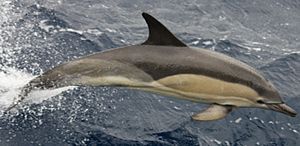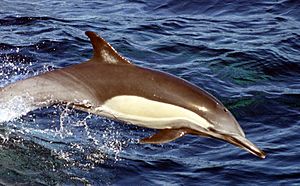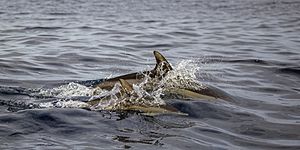Common dolphin facts for kids
Quick facts for kids Common dolphin |
|
|---|---|
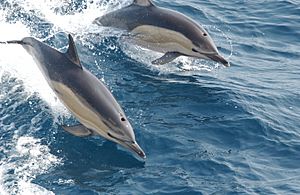 |
|
 |
|
| Size compared to an average human | |
| Conservation status | |
| Scientific classification | |
| Genus: |
Delphinus
|
| Species: |
delphis
|
| Subspecies | |
|
|
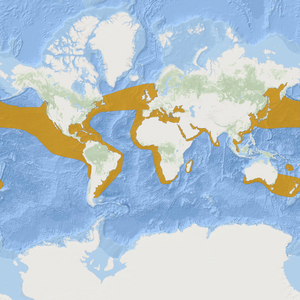 |
|
| Range of common dolphin | |
| Synonyms | |
|
|
The common dolphin (Delphinus delphis) is the most common cetacean (a group of marine mammals including whales and dolphins) in the world. There are about six million of them! Even though it's called "common," most people think of the bottlenose dolphin when they picture a dolphin. This is because bottlenose dolphins are often seen in aquariums and movies.
However, common dolphins were very important in ancient times. They often appeared in Ancient Greek and Roman art. A famous example is a painting by the Greek Minoan civilization.
The common dolphin is the only species in its group, called Delphinus. It is closely related to other dolphins like bottlenose dolphins, striped dolphins, and spinner dolphins. Scientists used to think there were two types of common dolphins: short-beaked and long-beaked. But now, they know that many long-beaked common dolphins around the world are not closely related. So, they are all considered the same species.
Contents
What Does a Common Dolphin Look Like?
Common dolphins are medium-sized. Adults are usually between 1.9 and 2.5 m (6.2 and 8.2 ft) long. They can weigh from 80–235 kg (176–518 lb), but most are between 80–150 kg (180–330 lb). Males are usually a bit bigger and heavier than females.
Their color pattern is quite special. Their back is dark, and their belly is white. On each side, they have an interesting hourglass shape. The front part of this shape is light grey, yellow, or gold, and the back part is dirty grey. They have a long, thin snout (called a rostrum) with many small, sharp, interlocking teeth. They can have up to 50–60 teeth on each side of their jaws!
Common Dolphin Family Tree
For a long time, all common dolphins were thought to be one species. But these dolphins live all over the world and come in different sizes, shapes, and colors. Over the years, scientists have suggested more than 20 different species!
In the 1960s, scientists in California decided there were two main types: long-beaked and short-beaked. The long-beaked common dolphin was thought to live in warm coastal waters in places like Africa, South America, Japan, and Oman.
Later, in the 1990s, a genetic study seemed to agree with this idea. This study also suggested a third type, called the Arabian common dolphin, found in the Red Sea and Indian Ocean. It has a very long, thin beak. However, today, this is usually seen as a subspecies of the common dolphin, not a separate species.
Recent studies show that long-beaked common dolphins from different parts of the world are not closely related. They often came from short-beaked ancestors. Because of this, long-beaked and short-beaked common dolphins are now considered the same species: Delphinus delphis.
Currently, the common dolphin is divided into four subspecies:
- D. d. delphis, the main subspecies
- D. d. bairdii, found in the Eastern North Pacific
- D. d. ponticus, found in the Black Sea
- D. d. tropicalis, found in the Indo-Pacific
Where Do Common Dolphins Live?
Common dolphins live in both warm and tropical waters around the world. You can find them from about 40–60 degrees North to 50 degrees South of the equator.
Long-beaked common dolphins usually prefer shallow, warm coastal waters. Short-beaked common dolphins like deeper waters, especially near underwater mountains (seamounts) and steep slopes (escarpments).
These dolphins eat many kinds of fish and squid. They can dive up to 200 metres (660 ft) deep to find food!
Common dolphins are found in many places. In the Northwest Atlantic, they live from North Carolina to Newfoundland. They are often found near the Gulf Stream, where warm currents bring lots of nutrients. In the Eastern Pacific, they live along the coast of California. You can also find them in Europe, the Black Sea, and the Mediterranean Sea. In the Southern Hemisphere, they are common around New Zealand and Australia.
They usually live in deep ocean waters, between 650 and 6,500 feet deep. Short-beaked dolphins prefer deeper waters than long-beaked ones. Water temperature is also important. In the Western North Atlantic, most common dolphins are seen in waters from 16 to 20 °C, but they can be found in waters as cold as 5 °C.
How Do Common Dolphins Behave?
Common dolphins live in huge groups! They are often seen in pods of several hundred individuals. These large groups sometimes come together to form "mega-pods" with over 10,000 dolphins!
Studies show that dolphins in a pod are not always close family members. Unlike some other dolphins, common dolphins do not live in a society led by females. However, related dolphins often stay in the same areas, showing they like to stick to certain places. Male common dolphins tend to stay closer to their relatives than females do.
Common dolphin pods can be made up of:
- Nursery pods (females and their babies)
- Bachelor pods (all males)
- Mixed groups (males, females, young adults, and babies)
It seems common dolphins live in "fission-fusion" societies. This means their groups are not always stable, and members can join or leave. We don't know if common dolphins form lifelong friendships with other dolphins, like male bottlenose dolphins do.
Common dolphins might use special "signature whistles," similar to bottlenose dolphins. These whistles are like a dolphin's name, helping them identify each other. A baby dolphin learns its unique whistle in about a year, and it stays the same for its whole life. These whistles might also help groups stay together, especially when feeding or diving. They could even act as a signal for lost dolphins to find their way back to the group.
Sometimes, common dolphins hang out with other dolphin species, like pilot whales. In the Gulf of Corinth, common dolphins often mix with striped and Risso's dolphins. They might chase each other playfully or even aggressively. They are often seen swimming and surfacing together.
Common dolphins are fast swimmers. They often jump out of the water (called breaching) and do amazing aerial tricks. They are also known to help injured members of their group.
Female short-beaked common dolphins are pregnant for 10 to 11 months. A newborn calf is about 70 to 100 centimetres (2.3 to 3.3 ft) long and weighs about 10 kilograms (22 lb). In the Black Sea, babies stop drinking milk around five to six months old. In other places, they might drink milk for up to 19 months. Females usually have a new baby every one to three years.
Common dolphins have even had babies with bottlenose dolphins in captivity. These hybrid babies can also have their own babies, showing they are fertile. There's even one confirmed case of a hybrid in the wild! A female bottlenose dolphin spent 10 years with a common dolphin pod and had a hybrid calf. This calf looked like a bottlenose dolphin in size but had the stripes and colors of a common dolphin.
How Do Humans Affect Common Dolphins?
Conservation Status
The common dolphin is probably the most common dolphin species on Earth. Because of this, it is listed as "Least Concern" by the IUCN Red List. This means it is not currently in danger of extinction.
Scientists have estimated how many common dolphins live in many parts of the world:
- Over 1.4 million off Japan and in the central Pacific.
- Nearly 1 million off the U.S. west coast.
- Almost 3 million in the eastern tropical Pacific.
- 70,000 in the western Atlantic.
- 467,000 in European waters.
- Over 19,400 in the Mediterranean Sea.
- Tens of thousands in the Black Sea.
- 20,000-22,000 in southern Australia.
- 15,000-20,000 off southern Africa.
Overall, there are likely more than six million common dolphins in the world's oceans!

Even though they are common, dolphins face some threats from humans. Some populations have been found to have moderate levels of metal pollution, which can be bad for their health. In Peru, some common dolphins have been hunted for food or to use as bait for sharks.
The biggest threat to common dolphins today is "bycatch." This means they get accidentally caught in fishing nets, especially large industrial nets like trawler nets and gillnets. In Europe, short-beaked common dolphins are the most common dolphin caught as bycatch. About 1,000 short-beaked common dolphins are caught each year in the North Atlantic.
In Galicia, Spain, many common dolphins are caught in trawler nets, especially at night when they are actively feeding. Most of the dolphins caught are males, suggesting that male pods might be more common in that area during certain seasons. If fishing were banned in shallower waters or at certain times, many dolphins could be saved.
Common dolphins used to be very common in the western Mediterranean Sea, but their numbers have dropped quickly since the 1960s. Scientists think this is because of a lot of human activity in the area.
To protect them, the common dolphin is listed on Appendix II of the Convention on Migratory Species (CMS). This means they benefit from international cooperation. The Mediterranean population of common dolphins is even on Appendix I, meaning they are in danger of extinction in that area and need strict protection. They are also covered by agreements to protect small cetaceans in the Baltic, North East Atlantic, Irish, North, Black, and Mediterranean Seas.
Mass Strandings
Sometimes, many dolphins wash ashore at once. This is called a "mass stranding event." On June 8, 2009, 26 common dolphins washed ashore in Falmouth Bay, UK. About the same number floated back out to sea. It's thought that naval activities might have caused this event.
Common Dolphins in Aquariums
Common dolphins are not often kept in aquariums. However, on a few occasions, beached common dolphins in California were cared for at SeaWorld San Diego. If they couldn't be released back into the ocean, they sometimes stayed at SeaWorld with bottlenose dolphins.
At SeaWorld, a male common dolphin once had babies with a female bottlenose dolphin, resulting in four hybrid calves! One of these hybrids, named Cindy or Bullet, stayed at SeaWorld San Diego. Another, named CJ, was at Discovery Cove and later moved to SeaWorld Orlando.
It is said that common dolphins are difficult to keep in captivity. Studies have shown that captive common dolphins can get stressed when swimmers are present. Unlike bottlenose dolphins, common dolphins tend to avoid swimmers and might show signs of stress, like surfacing more often. Their playful behavior also decreases when swimmers are around. This matches how wild common dolphins in New Zealand avoid swimmers.
See also
 In Spanish: Delfín común oceánico para niños
In Spanish: Delfín común oceánico para niños
- List of cetaceans
- Marine biology



